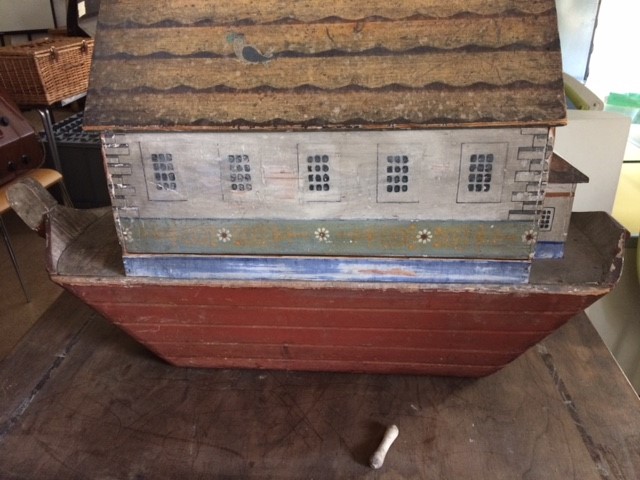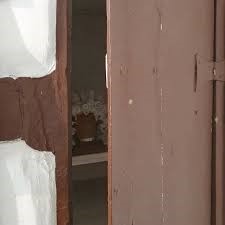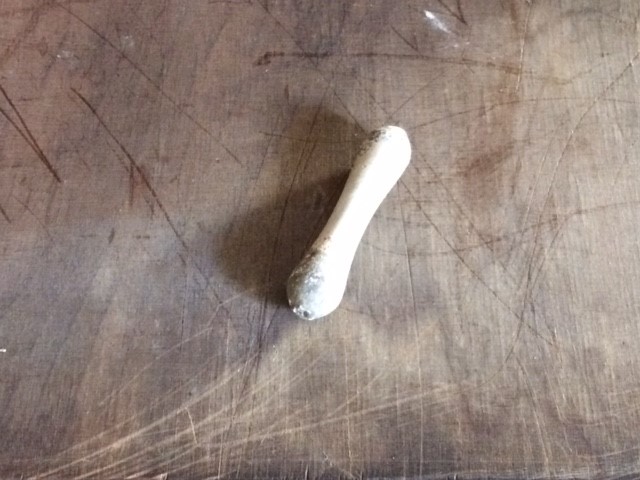Wigs and Wig-Curlers at the Museum of Cambridge
An artefact that we often forget about is the clay hair-curler, commonly called the ‘wig-curler’. Along with clay pipes, wig-curlers are a common archaeological find. Many have been recovered from the top layers of soil in Cambridge. They have even been found in strange places. I was surprised to find a pair as the sole occupants of a Noah’s Ark in the Museum of Cambridge. I had expected a range of animals, but they had clearly moved elsewhere. How the curlers got into the ark nobody seemed to know. Both items, however, relate well to the history of the museum. The Noah’s Ark is a fine example of nineteenth-century folk art, and the curlers rightly lead us to the wig closet in the museum’s Guest Room.

The Noah’s ark is a fine example of nineteenth-century folk art
The Wig Closet
The Museum of Cambridge is understandably proud of its wig closet as there are few, if any, such closets located in museum buildings. There are examples of wig-wearing in the 16th century by women such as Queen Elizabeth I and Mary Queen of Scots. But the vogue for powdered wigs started in France and England at the start of the 17th century. They then rose in popularity after the Civil War, once the kings appeared bewigged. In 1663, Samuel Pepys, the diarist and fashion icon, was surprised that wearing his periwig to church was treated as commonplace.
Wig-wearing continued into the 17th and 18th centuries. Visitors to the White Horse Inn (now the museum building) would have used the space to store their wigs and hair pieces, to re-powder them with finely-ground starch and to refresh them with essence of lavender or flower water. You could say that these were the 17th and 18th century equivalents of the hotel toiletries that are common today.

Under wigs, people would wear their hair very short or even shave it off. It is said that short natural hair decreased the number of head lice in the general population.
Wigs were common until the 1770s. But when a tax on hair powders was introduced in 1795 the vogue waned. The closets then became a place for storing and using the chamber pot. We can now understand why ladies in polite society refer to lavatories as ‘powder rooms’ or ask to ‘powder their noses’!
Wig Maintenance
As hair needs styling by brushing, combing and setting, so wigs also need attention. People commonly used white pipe-clay wig-curlers, also known as ‘roulettes’ or ‘bilboquet’, to set the curls in fashionable styles. Clay was not the only material used for curlers as various cane and wooden ones can also be found. IIt is suggested that the pipe-clay curlers belonged to the earlier vogue for wig-wearing in the 17th century. But no one can really be sure. These miniature dumbbells (about 3 inches long and wider at the ends than the middle) were the rollers of the day. Unlike pipes, it is difficult to find a chronology for wig-curlers. For the most part they were fairly rough and ready items with different sized curlers used for tighter and looser curls. As with pipes, makers could impress their marks, but this was not the norm.
Various 18th-century books on hairdressing include descriptions of how the curlers were used. As we know, heat helps set curls. The hair for wigs would be wound round the curlers and boiled in a pot of water over a fire for a full three hours. Thereafter they would be taken out to dry and, when dried, wrapped in brown paper parcels. Sometimes they would be sent to a pastry cook to be put in a crust and baked in an oven! Commonly bakers and cooks produced both wig-curlers and pipes, and specialist pipe sellers would have sold both sets of items. In fact, broken pipe stems were also used as curlers. Nothing was wasted!

Wig-curlers are modest but unusual items. One can but speculate about the people who used them – people who wore the wigs, and travellers to the White Horse in the 17th and 18th centuries.




